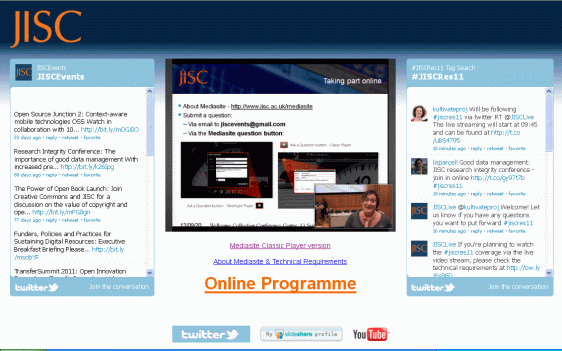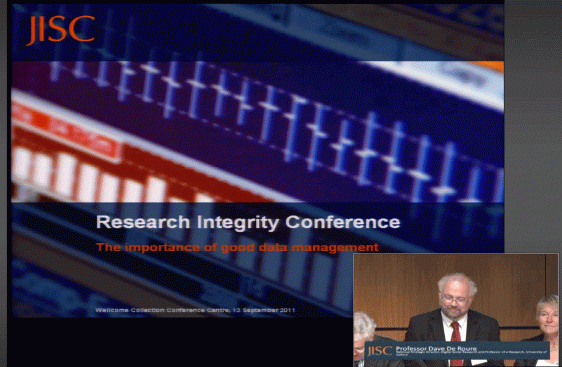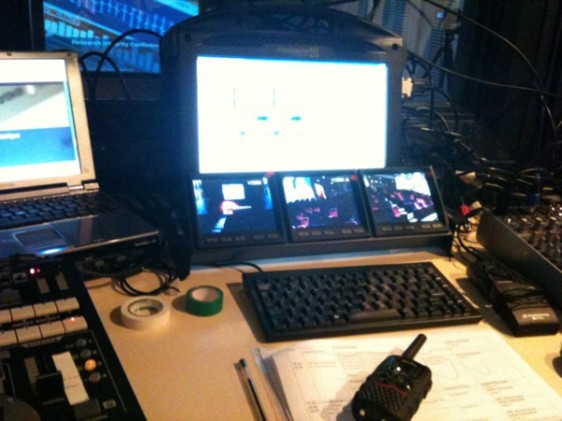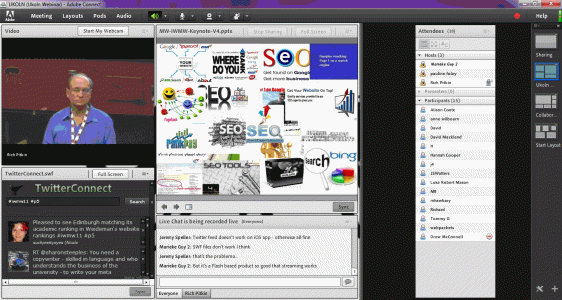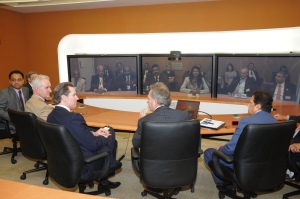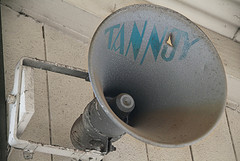
Tannoy by Solver1 (on Flickr)
This week is Open Access week #OAWeek and I felt that it would be appropriate for me to post something about the open access aspects of event amplification.
I’m sure most of you are familiar with the concept of event amplification as I’ve blogged about it many a time but just to bring everyone up to speed…
Event amplification makes use of networked technologies to amplify an event beyond the physical location. It is a pattern of behaviours rather than a prescriptive term and one could consider the following approaches:
- Amplification within an event – e.g. by use of Twitter between attendees
- Amplification outwards during an event – e.g. by video streaming of talks
- Amplification after an event – e.g. by sharing of slides or videos of presentations
I personally have always regarded event amplification in the academic sector as intrinsically open, though I realise that this isn’t actually the case. In the private/commercial sector there are many business models for event amplification and people often pay to view streaming or access resources. The streaming itself is often behind a firewall and people login and pay per view. It is likely, given the economic climate and changing face of online events, that these models could filter through to the academic sector. In efforts to test the water we have asked attendees of events we run (like IWMW) how they would feel about paying for content and this is an area we will continue to explore. Kirsty Pitkin (the Event Amplifier), with whom we have a good working relationship, designs custom event amplification and hybrid event plans, which can be open access or premium access. This way she enables event organisers to decide whether they want to simply spread their message and promote their event, or derive an additional revenue stream from making their event available online.
However having a business model in place should not prevent many aspects of event amplification from remaining free and open in the form of open content (such as slides on slideshare, documents and videos).
Staff Development
One key area facilitated by open access to events is staff development. Staff development it often one of the first areas to suffer when budgets are tight which is unfortunate given that there is clear indication that staff who are continually developed are happy, motivated staff. My colleague Brian Kelly is giving a presentation at this year’s Online Information Conference 2011 entitled Open Content and Open Events: Professional Development in an Amplified World. As Brian explains in his abstract:
“In the current economic and political climate it is often difficult for organisations to provide funding for attendance at conferences, seminars, workshops and other activities by which information professionals update their skills and enhance their professional networks. In addition, concerns related to the environmental impact of travel add new challenges to those involved in providing such events. Technological developments, including the availability of WiFi networks at many venues, increased ownership of mobile devices with networked capabilities and the wide variety of communication and collaborative tools available, offer new opportunities for the provision and ‘amplification’ of events to enhance professional skills, whether hybrid or online only. “
Using open content to support staff development has now become a fairly mainstream activity. I’m sure many of us have turned to YouTube or other online video services to work out how to fix our PC at some point or another. Screencasts are another excellent way in which we can use other people’s shared content to aid us in learning skills.
An interesting approach was taken by the Student Learning Centre at the University of Leicester in 2009. They decided to open-up their annual Learning and Teaching in the Sciences Conference (usually an internal event) in the form of a participant-driven ‘unconference‘, focused on the theme of assessment. Prior to the event they used many social networking tools to raise interest from both internal and external participants. They also created a Twitter hashtag for the day. On the day 20 participants watched plenaries and took part in group discussions. During the day Twitter messages containing the designated hashtag were projected on screen by a data projector via Twitterfall. Displaying these tweets allowed “the contributions of the participants in the room and the remote participants to be merged.” Not only this but “Twitterfall also allowed participants to see commentary from groups other than the one they were in, and to participate in multiple groups if they wished to.”
After the event extensive analysis was carried out on the Tweets from the day using tools like Twittertag and AGNA network analysis software, a free social network analysis tool. The data showed a high level of network connectivity between both internal and extenal Twitter users. Attendees were also asked to give their thoughts on how it went. There was a lot of positive feedback. Much of it centres round the openess of the event and the involvement of other people. As one participant put it “The best part of the meeting was talking with people other than ‘the usual suspects’.”
It is clear that opening out events brings in a new perspective that would probably have been missed by involving only those who have the time to physically attend. Not only this but it helps those who are physically there to see in new ways too. Openess brings an element of serendipity, as Marcel Proust once said “The real voyage of discovery consists not in seeking new landscapes but in having new eyes.”
Transparency and Impact
One other aspect of openess that is probably worth mentioning here is transparency. The move to transparency is something that is being driven very much by the government and I think is, on the whole, felt to be desirable by those working in academia. It brings with it a whole set of issues (I’m sure much will be written on open data during this week) but it allows people (and by people I mean both the public and those working in academia) to see more clearly what they are for their buck. Not only this but much more emphasis will be put upon impact and value for money. Kirsty Pitkin wrote an interesting blog post earlier this year on How Do We Measure Engagement?. In the post Kirsty reflects on a different blog post by Ann Priestley presenting a graph from Socious who use the high peak of activity during an event and sharp tapering of this activity after the event as part of their argument to sell their product. As both explain: Their implication is that unless your event has a long tail of post-event activity, it is not as successful at long-term engagement. Kirsty says that her concern is that it is easy to confuse “activity” and “engagement”. My concern is that you also need to add impact into the mix! As Kirsty concludes:
“There is no way to get a complete picture, any more than there’s a way to judge the way a paper handout is used post-conference. The only difference is that no-one questions the value of the paper handout! “
Her summary highlights the difficulties that lay ahead when trying to measure these areas:
“How we define engagement and impact will affect the types of metrics we attempt to collect to demonstrate the success of an amplified event over time. However, accepting that engagement with the event will not necessarily lead to clearly definable, traceable digital objects may be the first step in rethinking not just how measure success, but what we are trying to achieve through the event in the first place.“
Conclusions
There are many who say that open is always a good thing. I’d have to disagree, open raises a whole host of issues and many of them do not ultimately benefit the majority (I’m sure many of the positives and negatives will be explored in other posts during this week). That said open access to event amplification can be a positive thing and it brings with it a lot of pay back, so it will be a area that I will continue to explore.
One way in which I will be doing this is through my work on the Greening Events II Project funded by JISC Greening ICT Programme. We will be delviering a best practice report and guidelines on tools and approaches to event amplification.
0.000000
0.000000

